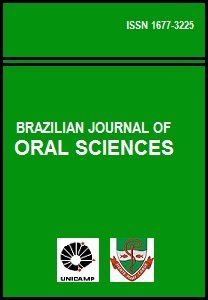Abstract
Aim: To analyze the dental arches by occlusal radiographs for possible gender differentiation. Methods: One hundred occlusal radiographic images were obtained. First, a median line and a line touching the vestibular portions of the projections of the maxillary central incisors were drawn. The intersection of these lines was called point I and from this point a line to the canine most vestibular portion was drawn, from the second premolar and second molar, from the left and right sides, in the maxillary and mandibular arches, thus obtaining the angle measurements. Line measurements relative to the width of the arches in three segments, canines, premolars and second molars were made. Results: The analyses performed by t-test indicated that all linear values obtained were statistically different (p<0.05), as may be seen in the values obtained from canine to canine, in which the female average was 3.48 cm (0.16) while the male average was 3.74 cm (0.21) and in respect to the angle measurements, only two angles have shown applicability in the definition of gender. Conclusions: Gender can be determined by analysis of occlusal radiographs with greater reliability when linear measurements are performed.
This work is licensed under a Creative Commons Attribution 4.0 International License.
Copyright (c) 2015 Letícia Ferreira dos Santos, Rodrigo Galo, Ricardo Henrique Alves da Silva
Downloads
Download data is not yet available.

